
My oldest daughter drove several hours to visit last weekend, partly because for two days, razor clam digging was allowed in my area. I dug razor clams when I was very young, when my family went camping at the beach. In those days, we were not allowed to keep any clams less than six inches long, though.
Later, when I was a young mother, I loaded everyone into the car during low tides and headed for the beach, which was only about thirty minutes away. We dug clams, let the children change in the car, and dropped them at school and their father off at work on the way home. I went home and cleaned all of those clams.

The rules had changed over the years, partly because the eight- and ten-inch clams we dug when I was young had become extremely rare. The average size of the clams had dropped, and new rules required each of us to keep the first fifteen clams dug. Even tiny clams had to be counted in our 15-clams-per-day limit. We did learn to hunt for bigger signs in the sand, but there was no foolproof way to predict which ones held tiny clams.
Broken clams also counted in the daily limit, even if the clams were unusable, or half was lost. That happened sometimes, no matter how careful we were. Miscalculating and digging too close to the mark in the sand sometimes meant our shovel blades cut into the clams. That made them harder to clean, and more of the flesh was lost. Besides, although broken clams could be used for chowder, they could not be butterflied and fried, as my mother used to do.
After I retired and moved back to Western Washington, I began to dig clams again. The sandy beaches where razor clams lived were less than a mile away from my home. There were not as many opportunities to dig clams as there had been many years ago. Low clam populations, red tides, and pollution issues often meant that only a few low tides were designated for clam digging each season, so we took advantage of any opportunity.
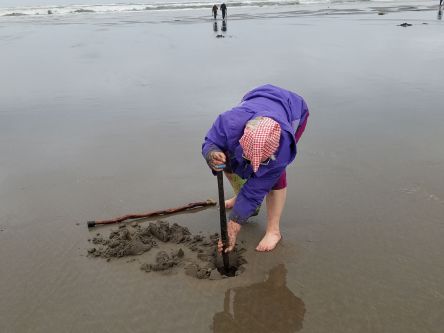
We had to find the clams, before we could dig them. We knew that when clams moved in the sand, they created suction that left marks on the sand’s surface, and people did everything they could to make the clams move. Some people stomped across the beach, watching carefully for developing marks. Others carried heavy sticks, or turned their shovels around and thumped the handles on the sand. Personally, I figured that with so many people on the beach, the clams moved just to escape all the ruckus.
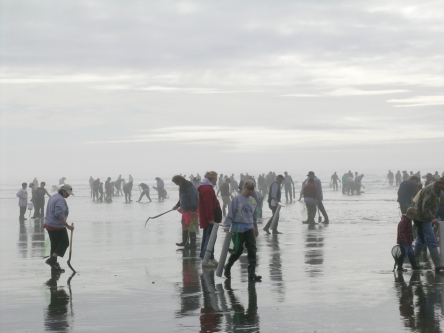
I have always used a clam shovel, and so did my children, when they were young. About the time my children were digging clams with me, a new clam-digging tool began to appear at the beaches. Called a clam gun, it was made of four-inch pipe, about two feet long. A short handle crossed the tube at the closed top, and a hole nearby allowed air to escape. I tried using a clam gun, pushing it into the sand at a slight angle toward the ocean, because the clams often sat just to the water side of the mark they left in the sand. Once I had pushed the clam gun into the sand as far as it would go, I had to place my thumb over the small hole in the top of the clam gun, and pull up. The suction caused by the tube being closed brought a narrow pillar of sand up out of the ground, ideally with a clam sitting within it. For decades, veteran clammers considered clam guns unsportsmanlike, because they made digging clams quicker and easier.

I found that I preferred using a shovel. To dig clams with a shovel, I turned my back to the ocean and inserted the shovel into the sand about six inches from the small mark—a dimple, donut, or hole—that showed the presence of a clam. Pushing the shovel straight down, I began to dig as fast as I could. When the hole was eighteen inches deep or so, I threw myself to my knees and began scooping sand out with my hands. Then I tried to feel around the edges of the hole for the clam I hoped was there. Once I found the clam, I held on as tightly as possible, and wiggled it free of the sand, pulling it to the surface to be rinsed and saved.
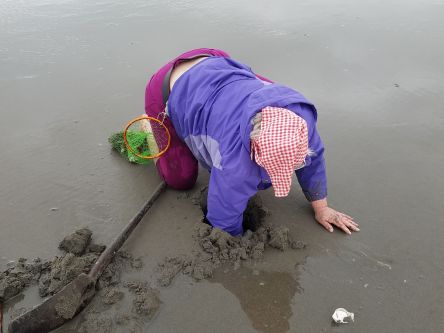
Not every hole yielded a clam, regardless of whether I used a clam gun or a shovel. Sometimes, the mark was deceptive, home only to a worm-like creature, or something I could not find. Other times, the clams were deep in the sand, and because they moved surprisingly quickly through moist sand, they escaped. If the weather had been stormy or rainy, it was hard to even find a mark that could indicate the presence of a clam. Sometimes they dug themselves so deep into the sand that they were difficult—or impossible—to retrieve. Sometimes, I was just wrong, and the mark wasn’t from a clam at all.
My oldest daughter was the best at spotting clams. As an artist, she had trained herself to spot variations in color and texture, and it served her well. In time, she developed a new way of finding clams. One day, she got her limit of clams before the rest of us were done. Rather than idly waiting for the rest of us to finish, she began to just dig random holes with her clam gun. We noticed that the disturbance caused by her clam gun made nearby clams to move, causing the dimples or holes they made to show. We hovered around her, pouncing on any marks that appeared. It was the only time I really found triggering the clams’ movements to be helpful, and we finished quickly.
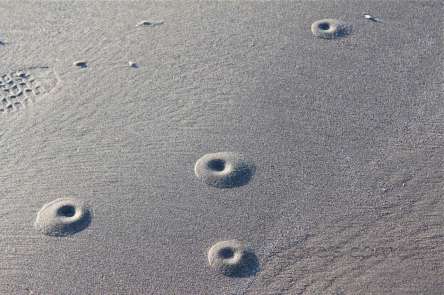
Once we got our fifteen clams apiece, and took them home, we had to clean them. Everyone pitched in, because unlike my mother, I was not willing to clean everyone’s clams. Some clams and mussels were eaten whole, but razor clams had some things that needed to be cleaned away and discarded.
First, I put the clams in a large bowl or pot of clean water, and put them in the refrigerator for the day. When I had rested, and was ready to go to work, I drained the fresh, living clams, and poured boiling water over them. Although it sounded cruel, it killed the clams quickly, and made them easier to clean.
The first thing I did, once the clams came out of their shells, was cut off the blackish end of the neck. Then, I clipped the zipper-like opening opposite the hinges of the shells. From the inside, I opened the double-tube neck, so I could rinse away all the sand. Besides, that made it lie flat for cooking.
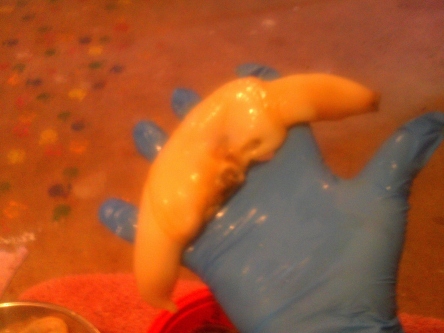
Cutting away the gills was trickier, although they were quite visible because of their brownish color. Again, scissors were my best option as I trimmed away the gills without severing any tissue.
Years ago, we tried very hard to keep the foot, or digger, attached to the clams, but we often failed, because the tissue surrounding it was paper thin and fragile. Later, I learned to cut it off and save it for chowder. I still had to open it up, though, to remove lines of dark entrails and a strange, clear, cylindrical object that I was told helped the clams dig through the sand. Finally I was left with clean, creamy, edible clam flesh.
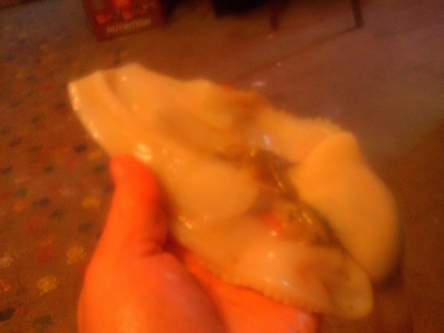
I usually kept a few clams for frying, and I spread those out on plastic wrap, butterflied and flattened, so I could pull them out of the freezer later on. I always dipped them in beaten eggs and flour first, and then left them in the refrigerator for a few hours, so the breading would stick to the flesh. Sometimes, I chopped a few clams into chunks to sautee them, and that was nice too. Most of the clams, especially those that had been broken either while digging or cleaning, I ground up and froze in small packages, for chowder or fritters. In my early married days, I canned the ground up clams, and the strained broth from blanching them—because adding that to a pot of chowder increased the clam flavor, and that was a very good thing.
Whole or ground, clams froze well, though, and I switched to that method after I retired. When I wanted to make chowder, or mix the clam meat with some flour, egg, and salt to fry up as fritters, all I had to do was pull a bag of clam meat out of the freezer.

My daughter and I spent a few hours at the beach, spread over the two mornings on which clam digging was allowed. We enjoyed walking barefoot in the sand, and visiting with other clammers. We found plenty of clear marks from clams in the sand, and though she used a clam gun and I used a shovel, we both got our clams at about the same rate. It didn’t take long to get the clams cleaned and packaged for freezing. Over the next few months, I will enjoy eating clams, in one form or another. Every time I do, I will remember not only digging these clams with my daughter, but also digging with my children many years ago, and digging with my parents even longer ago. Digging clams is not just about finding food, or participating in an entertaining activity. It’s about building memories that last a lot longer than the clams themselves.